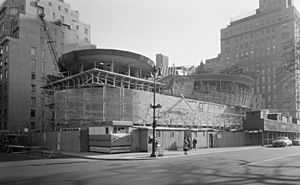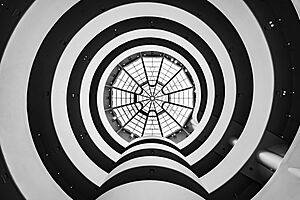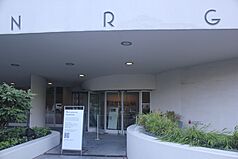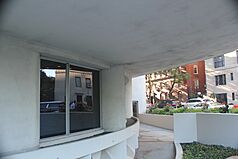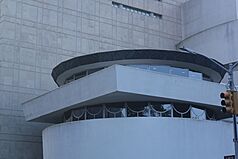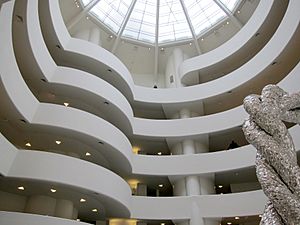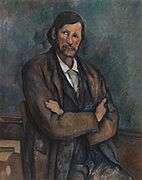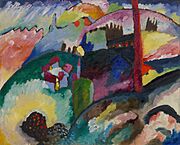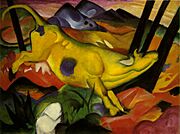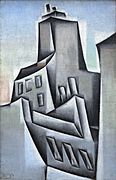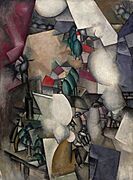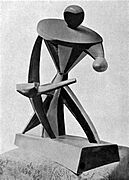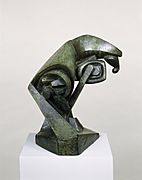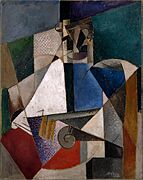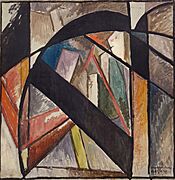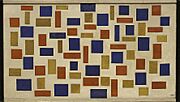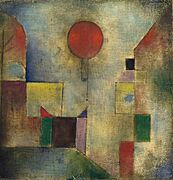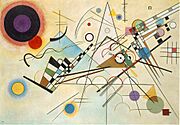Solomon R. Guggenheim Museum facts for kids
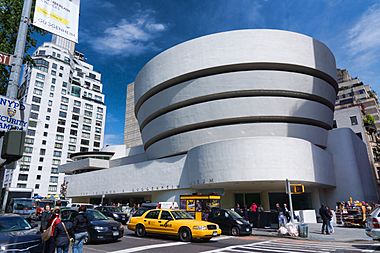
View from Fifth Avenue
|
|
| Established | 1939 |
|---|---|
| Location | 1071 Fifth Avenue at 89th Street Manhattan, New York City |
| Type | Art museum |
| Visitors | 861,000 (2023) |
| Public transit access | Subway: Bus: M1, M2, M3, M4, M86 SBS |
| Built | 1956–1959 |
| Architect | Frank Lloyd Wright |
| Architectural style(s) | Modern |
| Criteria | Cultural: (ii) |
| Designated | 2019 (43rd session) |
| Part of | The 20th-Century Architecture of Frank Lloyd Wright |
| Reference no. | 1496-008 |
| Region | North America |
| Designated | May 19, 2005 |
| Reference no. | 05000443 |
| Designated | October 6, 2008 |
|
Invalid designation
|
|
| Designated | March 25, 2005 |
| Reference no. | 06101.008546 |
| Designated | August 14, 1990 |
| Reference no. | 1774 (exterior), 1775 (interior) |
The Solomon R. Guggenheim Museum, often called The Guggenheim, is a famous art museum in New York City. It is located on Fifth Avenue in Manhattan. The museum is known for its amazing collection of Impressionist, Post-Impressionist, early Modern, and contemporary art. It also hosts special art shows all year long.
The museum was started in 1939 by the Solomon R. Guggenheim Foundation. It was first called the Museum of Non-Objective Painting. Its first director was Hilla von Rebay. In 1952, it was renamed after its founder, Solomon R. Guggenheim. The same foundation still owns and runs the museum today.
The building itself is a masterpiece of 20th-century architecture. It was designed by the famous architect Frank Lloyd Wright. The building's unusual spiral shape was quite new and exciting when it was finished in 1959. It took 15 years to design and build. The main part of the museum is a six-story, bowl-shaped gallery. A long, winding ramp goes up along the inside, under a big skylight. The building was renovated several times, including from 1990 to 1992 and again from 2005 to 2008.
Over the years, the museum's art collection has grown a lot. It includes art from many important private collections. Some of these came from Guggenheim himself, Justin Thannhauser, and Robert Mapplethorpe. As of 2022, the museum has about 8,000 artworks. Some of these are shared with other Guggenheim museums in Bilbao, Spain, and Venice, Italy. In 2023, about 861,000 people visited the museum.
Contents
Museum History
How the Museum Started
Solomon R. Guggenheim came from a rich mining family. He started collecting art in the 1890s. In 1926, he met artist Hilla von Rebay. She showed him exciting new European art, especially abstract art. This art, called "non-objective art," focused on feelings and ideas, not real-world objects. Guggenheim loved it and changed his whole way of collecting. He started buying works by artists like Wassily Kandinsky.
Guggenheim began showing his art collection in his apartment. He and Rebay soon thought about building a museum. In 1937, Guggenheim created the Solomon R. Guggenheim Foundation. Its goal was to help people appreciate modern art.

The foundation's first museum opened in 1939. It was called the Museum of Non-Objective Painting. Hilla Rebay was its director. She wanted to collect the best non-objective art from early modern artists. By the early 1940s, the collection was so big that a permanent museum was clearly needed.
Designing the Building
In 1943, Rebay and Guggenheim asked Frank Lloyd Wright to design the new museum. Wright was a famous architect. He was excited to create a unique building in a city. He believed most museums were not "properly designed." Wright was hired in June 1943.
Rebay wanted a special place for modern art. She told Wright she wanted "a temple of spirit, a monument!" Wright's design was very modern and personal. It changed how architects thought about museum design. The Guggenheim is the only museum Wright designed in a city. This meant he had to design it tall, not wide. It took him 15 years, with many sketches and plans, to finish the museum.

Wright created several designs for the museum. Most of them had circular shapes and a ramp that went around the building. He wanted a space where a "wheelchair [could go] around and up and down." His first idea looked like an upside-down "ziggurat," an ancient stepped building. Some experts think he was inspired by a spiral staircase in the Vatican Museums.
Choosing the Location
Wright thought the museum would be in downtown Manhattan. But in 1944, Rebay and Guggenheim bought land on the Upper East Side. It was on Fifth Avenue, next to Central Park. Guggenheim liked this spot because the park offered a break from city noise. Wright's early sketches fit the site almost perfectly.
In 1945, Wright's designs were announced. The main part of the building would have a spiral ramp around a lightwell with a skylight. Visitors would take an elevator to the top. Then, they would walk down the ramp to see the art.
Challenges and Changes
Building the museum faced many delays. First, there were material shortages during World War II. Then, construction costs went up. Rebay and Wright also disagreed on some design details. Wright kept changing his plans, especially about how the building would be lit.
Solomon Guggenheim died in 1949. After his death, some people on the museum's board wanted to change Wright's design. They also wanted to remove Rebay from her leadership role. But Wright convinced the Guggenheim family to buy more land. This allowed his full design to be built.
In 1951, the foundation bought another building. This gave them a continuous space on Fifth Avenue. Wright redesigned the museum again, adding a multi-story annex. The museum also decided to show "objective" art, not just abstract art. Rebay disagreed with this and resigned in 1952. The museum was then renamed the Solomon R. Guggenheim Museum.
New Directors and Construction
James Johnson Sweeney became the museum's director in 1952. He expanded the types of art the museum collected. He also started showing art that Rebay had put in storage.
Sweeney and Wright often disagreed. Sweeney thought the building's design should not overshadow the art. He made Wright change the plans to include more offices and storage. The city also had concerns about the design meeting building codes. Wright had to make many changes.
Construction finally began in August 1956. Wright opened an office in New York City to oversee the work. The building was Wright's last major project. He died in April 1959, just six months before the museum opened. Sweeney made some changes against Wright's wishes, like painting the walls white.
The museum officially opened on October 21, 1959. Its unique design was generally good for the art shows it hosted.
Expanding the Collection
Thomas M. Messer became director in 1961. He stayed for 27 years, the longest of any director there. Under his leadership, the museum's collection grew a lot. It started collecting more contemporary art, including works from Europe and Latin America.
When Messer started, some people worried the curved walls would make it hard to show art. In 1962, he put on a big show combining paintings with sculptures. He learned how to use special stands to make the art look right in the unusual space.
In 1963, the museum received a private collection from art dealer Justin Thannhauser. This collection included many Impressionist and Post-Impressionist works. To make space, the museum renovated part of the building. In 1968, a two-story annex was added. This gave the museum more room for its growing collection.
By the 1970s, the museum needed more money and space. It added a dining area and bookstore in the old driveway. In the 1980s, plans for a new 10-story annex were approved. This annex would greatly increase the museum's exhibit space.
Modern Era and Renovations
Thomas Krens became director in 1988. He greatly expanded the museum's collections and opened new Guggenheim museums around the world. He also brought in very popular exhibitions, like "Africa: The Art of a Continent" and "China: 5,000 Years." One unusual show was "The Art of the Motorcycle," which displayed motorcycles as art.
In the early 1990s, the museum underwent a big renovation. It closed for 18 months. The 89th Street annex was built, and the main gallery's exhibition space almost doubled. This allowed the museum to show more of its permanent collection. The windows and skylights were also restored.
To pay for these changes, the museum sold some artworks. This caused some debate, but Krens said it helped expand the museum's international collection. He was known for making the Guggenheim a global brand.
In the early 2000s, the museum opened an arts center in the basement. It was renamed the Gail May Engelberg Center for Arts Education in 2022. By 2004, the building needed another restoration to fix leaks and update its systems. This $29 million project was completed in 2008.
Richard Armstrong became director in 2008. He focused on growing the permanent collections and working with other museums. In 2019, many museum workers joined a labor union. The museum also started efforts to increase diversity. During the COVID-19 pandemic, the museum closed temporarily in March 2020. It reopened later that year. Armstrong retired at the end of 2023.
In June 2024, Mariët Westermann became the Guggenheim's first female director. She has made some changes to the staff to help the museum's finances.
Building Design
Wright's design for the Guggenheim Museum uses many geometric shapes. You can see squares, circles, rectangles, and triangles. The building has two main spiral parts: the six-story main gallery and a smaller "monitor" section. A rectangular annex stands behind them.
The building shows Wright's idea of "organic architecture." This means the building's shapes are inspired by nature. Wright said the shapes had special meanings: "the circle, infinity; the triangle, structural unity; the spiral, organic progress; the square, integrity." You can see circles everywhere, from the main gallery to the floor designs.
Outside the Museum
Wright wanted a marble outside, but the builder used a type of sprayed concrete called "gunite" to save money. The outside was covered in an ivory-colored plastic coating. This coating cracked over time. During later renovations, workers found that the building was originally a brownish-yellow color.
The sidewalk in front of the museum has metal circles, just like the floors inside. There are also curved walls around planting beds.
Main Building Features
The main entrance is on Fifth Avenue. It has glass doors set back in a small lobby. Above the entrance is a "bridge" that connects the main gallery and the monitor building. The main gallery rises like a "bowl" with concrete "bands" and skylights. From the street, it looks like a white ribbon spiraling upwards. This look is very different from the rectangular buildings around it.
The monitor section is a four-story wing. It has a round concrete outside on its lower floors. The upper floors stick out further. This section houses the Thannhauser Collection.
The Annex Tower
Wright's original plan included a ten-story tower for offices and apartments. This part was not built until the 1990s renovation. The new 10-story annex was designed to match Wright's ideas. It has a limestone grid on its outside. This annex provides more exhibition space and offices.
Inside the Museum
The inside of the Guggenheim has the monitor section, the main gallery, and a lecture hall below the main gallery. The bookstore is near the main entrance. The museum's interior is mostly painted white.
The Main Gallery Rotunda
Wright designed the main gallery as a big open space, or rotunda, with a spiral ramp. Visitors take an elevator to the top. Then, they walk down the ramp, seeing the art as they go. The ramp is like a nautilus shell, with spaces flowing into each other. This open design lets visitors see art on different levels at the same time.
The ramp is made of concrete and goes up at a gentle slope. It is about 1,416 feet long. The walls are tilted at a 97-degree angle. Wright wanted these low ceilings and slanted walls to create a "more intimate environment" for the art. Paintings are hung on horizontal bars that stick out from the sloped wall.
The main gallery has a big domed skylight at the top. It is about 95 feet high. This skylight and other windows were restored in 1992.
Thannhauser Collection Area
The museum's "monitor" section holds the Thannhauser Collection. Its galleries are circular. This area was originally planned for apartments but became offices and storage. In the 1960s and 1980s, parts of it were turned into exhibition space. During the 1990s renovation, the second through fourth floors became the Thannhauser Building.
Arts Education Center
The Gail May Engelberg Center for Arts Education opened in 2001. It is in the basement, below the main gallery. This center offers classes and lectures about art. It has labs, exhibition spaces, and a 266-seat Peter B. Lewis Theater. The center was renamed in 2022 after a generous donation from Gail May Engelberg and her husband.
Annex Galleries
The 89th Street annex has 10,290 square feet of extra exhibition space. It has four galleries with flat walls, which are good for displaying art. A lobby connects the annex to the monitor section.
Special Building Status
The New York City Landmarks Preservation Commission (LPC) made the museum building a New York City landmark in 1990. It was one of the youngest buildings to get this status.
The museum was added to the National Register of Historic Places in 2005. It became a National Historic Landmark in 2008. In 2019, UNESCO added the Guggenheim to the World Heritage List. It was recognized as part of "The 20th-Century Architecture of Frank Lloyd Wright."
Art Collection
The Guggenheim has about 8,000 artworks in its collection. About 1,700 of these can be seen online. The museum building is not huge, so it can only show a small part of its collection at one time. Other artworks are kept in storage. Unlike many art museums, the Guggenheim does not divide its collection into different departments. The permanent collection is usually shown in the side galleries and annexes. The main gallery is often used for special exhibitions.
The Guggenheim shares its collection with its sister museums. These are the Peggy Guggenheim Collection in Venice, Italy, and the Guggenheim Museum Bilbao in Spain.
Important Art Collections
The Guggenheim Museum has received many private art collections over the years. These include collections from Guggenheim, Karl Nierendorf, Katherine Sophie Dreier, Justin Thannhauser, and Robert Mapplethorpe. The earliest works include modern artists like Rudolf Bauer, Rebay, Kandinsky, Piet Mondrian, Marc Chagall, and Pablo Picasso.
In 2007, 620 of the original artworks were named the Solomon R. Guggenheim Founding Collection. This includes over 150 works by Kandinsky. It also has pieces by Albert Gleizes, such as Brooklyn Bridge. Other famous works include Chagall's Green Violinist and Picasso's The Accordionist.
In 1948, the museum bought 730 objects from Karl Nierendorf. These included many German expressionist paintings. In 1953, the museum got 28 pieces from Katherine Sophie Dreier's collection. These included works by Alexander Calder and Mondrian.
The Thannhauser Collection, received in 1963, had 73 works. These were mostly Impressionist, Post-Impressionist, and French modern styles. It included art by Paul Gauguin, Vincent van Gogh, and 32 works by Picasso.
Rebay also left over 600 artworks to the Guggenheim in her will. These included works by Kandinsky, Klee, and Calder. In 1990, the museum acquired the collection of Giuseppe Panza. This collection has minimalist sculptures and paintings.
In 1992, the Robert Mapplethorpe Foundation gave 200 of Mapplethorpe's best photographs to the museum. This was the museum's first big collection of 20th-century photography. In 2001, the museum received the Bohen Foundation's collection. This collection focuses on film, video, photography, and new media. In 2022, the Guggenheim received 100 works from the D. Daskalopoulos Collection.
Other Famous Artworks
Over the years, the Guggenheim has acquired many other important artworks. These include sculptures by Constantin Brâncuși and Alexander Calder. It also has paintings by Paul Cézanne, Willem de Kooning, and Jackson Pollock.
The museum's collection now includes figurative art, which shows real-world objects and people. This is different from its early focus on "non-objective painting." Some examples include Francis Bacon's Three Studies for a Crucifixion and Roy Lichtenstein's Grrrrrrrrrrr!!.
Selected works in the collection
-
Paul Cézanne, around 1899, Man With Crossed Arms
-
Georges Braque, 1909, Violin and Palette
-
Wassily Kandinsky, 1910, Landscape with Factory Chimney
-
Franz Marc, 1911, The Yellow Cow
-
Fernand Léger, 1911–12, The Smokers
-
Alexander Archipenko, 1913, Pierrot-carrousel
-
Raymond Duchamp-Villon, 1914 (cast around 1930), The Horse
-
Albert Gleizes, 1914–15, Portrait of an Army Doctor
-
Theo van Doesburg, 1918, Composition XI
-
Paul Klee, 1922, Red Balloon
-
Wassily Kandinsky, 1923, Composition 8
Art Ownership Questions
Sometimes, questions come up about who truly owns certain artworks. In 2007, the family of a Berlin banker asked for a Picasso painting back. They said it was sold unfairly during a difficult time. The museum and the family reached an agreement in 2009.
In 2018, the museum returned a painting called Artillerymen by Ernst Ludwig Kirchner. This painting had been taken from its owner during a difficult period in history. In 2023, another family asked for a Picasso painting, Woman Ironing, back. They said it was sold for a very low price to escape a dangerous situation. The museum says it contacted the family before getting the painting and they did not object at that time.
The Guggenheim lists 289 artworks on a special website that helps track art from difficult historical periods.
How the Museum is Run
The Solomon R. Guggenheim Foundation owns and runs the Solomon R. Guggenheim Museum. A committee helps decide which artworks to buy or sell. The foundation's board of trustees makes the final decisions. J. Tomilson Hill has been the board's chair since 2021. The museum had 315 full-time and part-time staff members in 2020.
Visitors to the Museum
When the museum first opened, many people came to see it. A survey in 1960 found that most visitors came to see the building itself, or both the building and the art.
Before its big renovation in the 1990s, about 600,000 people visited each year. This number grew to between 900,000 and 1 million by the early 2000s. In 2013, almost 1.2 million people visited. Due to the COVID-19 pandemic, only 154,000 visitors came in 2020. In 2023, the museum had 861,000 visitors.
Surveys show that many visitors come because of the building's unique architecture. In 2001, about 70 percent of visitors were tourists. In 2018, a study showed that most visitors were white.
Some exhibitions have been very popular. A show about Frank Lloyd Wright in 2009 attracted 372,000 visitors. In 2019, an exhibition of Hilma af Klint paintings was the most popular ever. It brought in over 600,000 visitors in six months.
See also
 In Spanish: Museo Solomon R. Guggenheim para niños
In Spanish: Museo Solomon R. Guggenheim para niños
- List of Frank Lloyd Wright works
- List of Guggenheim Museums
- List of most-visited museums in the United States
- List of National Historic Landmarks in New York City
- List of New York City Designated Landmarks in Manhattan from 59th to 110th Streets
- List of World Heritage Sites in the United States
- National Register of Historic Places listings in Manhattan from 59th to 110th Streets


